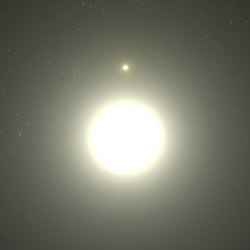
Polaris with its faint companions. Image credit: Greg Bacon (STScI) Click to enlarge
We tend to think of the North Star, Polaris, as a steady, solitary point of light that guided sailors in ages past. But there is more to the North Star than meets the eye – two faint stellar companions. The North Star is actually a triple star system. And while one companion can be seen easily through small telescopes, the other hugs Polaris so tightly that it has never been seen directly – until now.
By stretching the capabilities of NASA’s Hubble Space Telescope to the limit, astronomers have photographed the close companion of Polaris for the first time. They presented their findings today in a press conference at the 207th meeting of the American Astronomical Society in Washington, DC.
“The star we observed is so close to Polaris that we needed every available bit of Hubble’s resolution to see it,” said Smithsonian astronomer Nancy Evans (Harvard-Smithsonian Center for Astrophysics).
The companion proved to be less than two-tenths of an arcsecond from Polaris – an incredibly tiny angle equivalent to the apparent diameter of a quarter located 19 miles away. At the system’s distance of 430 light-years, that translates into a physical separation of about 2 billion miles.
“The brightness difference between the two stars made it even more difficult to resolve them,” stated Howard Bond of the Space Telescope Science Institute (STScI). Polaris is a supergiant more than two thousand times brighter than the Sun, while its companion is a main-sequence star. “With Hubble, we’ve pulled the North Star’s companion out of the shadows and into the spotlight.”
By watching the motion of the companion star, Evans and her colleagues expect to learn not only the stars’ orbits but also their masses. Measuring the mass of a star is one of the most difficult tasks facing stellar astronomers.
Astronomers want to determine the mass of Polaris accurately because it is the nearest Cepheid variable star. Cepheids are used to measure the distance to galaxies and the expansion rate of the universe, so it is essential to understand their physics and evolution. Knowing their mass is the most important ingredient in this understanding.
“Studying binary stars is the best available way to measure the masses of stars,” said science team member Gail Schaefer of STScI.
“We only have the binary stars that nature provided us,” added Bond. “With the best instruments like Hubble, we can push farther into space and study more of them up close.”
The researchers plan to continue observing the Polaris system for several years. In that time, the movement of the small companion in its 30-year orbit around the primary should be detectable.
“Our ultimate goal is the get an accurate mass for Polaris,” said Evans. “To do that, the next milestone is to measure the motion of the companion in its orbit.”
Headquartered in Cambridge, Mass., the Harvard-Smithsonian Center for Astrophysics (CfA) is a joint collaboration between the Smithsonian Astrophysical Observatory and the Harvard College Observatory. CfA scientists, organized into six research divisions, study the origin, evolution and ultimate fate of the universe.
Original Source: CfA News Release
